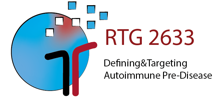A5: Chronic danger signaling as driver of autoimmunity in granulomatosis with polyangiitis
Background. Break of tolerance is the fundamental step in development of autoimmune diseases. Dysregulation of cell death accompanied by excessive release of danger associated molecular patterns (DAMP) contributes to the break of tolerance. DAMP act as endogenous adjuvants perpetuating self-reactivity, chronic, non-resolving inflammation and subsequent tissue damage. In GPA, which is characterized by chronic granulomatous inflammation and systemic autoimmune vasculitis, we showed inflammation- and pathogen-driven alterations of the adaptive immune response (J Autoimmun. 78:79). Moreover, we demonstrated (i) anomalous expression of the autoantigen proteinase 3 (PR3) and dysregulation of neutrophil cell death that contributes to non-resolving inflammation (Fig. A5-1; J Clin Invest 125: 4107), and (ii) cell death-related release of two prototypic DAMP (HMGB1, IL-33) that contributed to receptor-mediated pro-inflammatory responses within the inflamed tissue in GPA. A causal link between persistent danger signaling and loss of tolerance against PR3 in GPA has to be proven yet.
Objectives. (i) Characterization of molecular patterns involved in danger signaling in GPA. (ii) Analysis of the adjuvant function of DAMP (e.g. HMGB1) and their interaction with PR3 in the induction of inflammation and autoimmunity by in vitro and in vivo experiments.
Work program. In GPA patients, molecular patterns of danger signals will be analyzed by immunoblotting, multiplex arrays, and immunohistochemistry. These will be correlated with disease parameters and compared between diseased subjects and healthy controls. Complex statistical analysis will be performed together with A9. Binding affinity of different HMGB1 isoforms to PR3 will be determined using microscale thermophoresis. The adjuvant function of HMGB1 will be evaluated using cell lines engineered to express human PR3. In addition, in various mouse strains, including a human PR3-transgenic mouse, induction of autoantibodies (i.e. PR3-ANCA) following HMGB1 and PR3 co-stimulation will be determined.

- Projects
- A: Defining Autoimmune Pre-Disease
- A1: Define the impact of shift work on autoimmunity and autoimmune diseases
- A2: B cells as drivers towards clinical SLE manifestation
- A3: G protein-coupled receptors orchestrating granulocytes in pemphigoid diseases
- A4: Epitope-dependent autoantibody-mediated skin inflammation in pemphigoid disease
- A5: Chronic danger signaling as driver of autoimmunity in granulomatosis with polyangiitis
- A6: T cell memory differentiation in early autoimmune disease
- A7: CD4+ T cell receptor sequences during progression towards experimental pemphigoid.
- A8: The C5aR2 pathway as a checkpoint for B cell activation in autoimmunity.
- A9: Genetic and molecular similarity of autoimmune disease
- B: Targeting of Autoimmune Pre-Disease
- Associated projects
- MD projects
- Associated MD projects
- Concluded Projects
- A: Defining Autoimmune Pre-Disease







